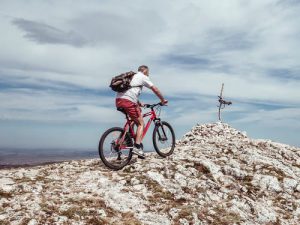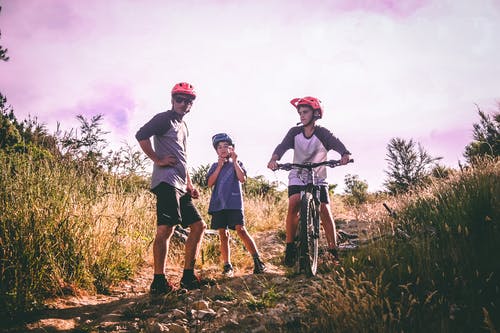Mountain biking is the sport of off-road cycling, often over rough terrain, using specially designed mountain bikes.
Mountain bikes share similarities to other motorcycles but include features designed to improve durability and performance on rough terrain.
Mountain biking can usually be divided into several categories: cross, trail, all mountains (also called “Enduro”), downhill, freeride and dirt. However, most mountain biking is in the Trail and Cross Country style category.
The sport requires endurance, basic strength and balance, bike handling skills and confidence. Advanced riders chase both steep technical descents and high inclines on slopes.
In the case of freeriding, downhill skiing and mud, air maneuvers are performed both with natural features and with the help of specially designed jumps and ramps.

Mountain bikers ride off-road trails such as a singlet track, country roads, fire roads and often resort to ski resorts that remain open for such activities in the summer. Since riders are often far removed from civilization, there is a strong self-reliance ethic in this.
Riders learn to repair broken bicycles and flat tires to avoid twisting. Many riders carry a backpack, including water, food, troll repair tools, and a first aid kit in case of injury. Group rides are common, especially on longer hikes. Mountain bike orienteering adds map navigation skill to mountain biking.
Table of Contents
Pluses of Mountain Biking
1. Mountain Cycling improves sleep
Regular physical activity helps to eliminate cortisol, the so-called stress hormone, from the body. Therefore, an evening bike ride will help you get rid of insomnia, and a morning bike ride will help you wake up quickly.
2. Mountain Cycling improves digestion
Cycling speeds up your metabolism, which can increase your appetite and improve food digestion. Remember how you feel like eating after a long bike ride? So, the appearance of appetite is a sign of an active metabolism.
3.Mountain Cycling improves endurance
By cycling regularly, you will increase your overall endurance. Within a few months, you will begin to feel more cheerful, it will become easier to endure stress during the working day, and your emotional background will stabilize.
4. Mountain Cycling promotes weight loss
The bike is the best friend of people who want to lose those extra kgs! During skiing, a large number of calories are burned, and unwanted deposits in the thigh area are also reduced.
At the same time, your body burns fat not only during the trip, but also for several hours after it. And those who drive fast, but for short distances, burn several times more fat than those who drive serious distances, but slowly.
5. Mountain Cycling improves skin condition
Cycling accelerates blood circulation, which helps to slow down skin aging. Also, while riding, ideal conditions are created for the production of collagen, which slows down the formation of wrinkles.
6. Mountain Cycling increases muscle tone
By regularly riding your bike, you will train the muscles of your legs, chest, back, arms and abdomen at the same time. This will help you tone up and improve your fitness.
7. Mountain Cycling reduces stress
In the process of skiing, the body produces the hormone of happiness. In addition to this, while cycling, as with any cyclic sport, breathing evens out, which helps to bring thoughts and feelings in order.
8. Mountain Cycling strengthens the nervous system
Regular cycling has a positive effect on the emotional state, improves mood and general well-being, and also gives a boost of vigor. All this helps to strengthen the nervous system after a hard day’s work.
9. Mountain Cycling improves thinking ability
Cycling significantly increases the flow of blood and oxygen to the brain, which activates receptors and encourages the creation of new brain cells in the hippocampus, the region responsible for memory. It’s no coincidence that many creative people use cycling to stimulate thinking.

Types of Mountain Bikes
The main division of mountain bikes is the presence or absence of a rear shock absorber.
Those models that do not have a rear shock absorber are called hardtails (hardtail in English means “hard tail”, that is, a rigid rear part of the bike), and those that have one are called double suspensions (full-suspension is translated as “full suspension” , i.e. there are two shock absorbers on the bike).
Hardtails and double suspensions are also divided into subspecies according to their intended purpose.
Hardtails
Hardtails are the most popular type of bicycles due to their huge prevalence, a large assortment in stores, an optimal price / performance ratio, versatility (suitable for both off-road and asphalt) and other points reflected in the article on types of bicycles.
1.Cross Country Hardtails
This name is used by both ordinary walking mountain bikes and professional models created for participation in cross-country races.
Features of XC hardtails:
- light aluminum alloy frame,
- front shock absorber (suspension fork),
- sturdy 26 “or 29” wheels,
- rubber with mud (“toothy”) tread,
- rim or disc (mechanical, hydraulic) brakes,
- speeds from 18 to 27,
- a fairly narrow sports saddle,
- lack of wings.
2. Extreme hardtails
A special version of hardtails for stunt riding in disciplines such as street (street), dirt jumping (dirt jumping), etc.
Features of Extreme Hardtails:
- reinforced frame with a heavily lowered top tube for easy stunts,
- frame material – aluminum or steel (recently steel frames have become very popular, because now they are comparable in weight to aluminum ones, but at the same time they are considered stronger and more weldable in case of breakdown),
- small frame sizes – when choosing such a bike, you will not be able to follow the usual
- size table; frames are often available in one or two sizes,
- a stronger front shock or a stiffer fork
- wheels 26 “or 24” inches (24 “wheels are now more common – with them the bike is more compact and maneuverable).
Full suspensions mountain bikes
Full suspensions are mountain bikes with two shock absorbers. They give you unrivaled control of the road in all weather conditions, allowing you to take tight turns at high speed, no matter what is under the wheels. Full suspension is categorized by riding style – from light XC to very robust downhill models.
1.Cross Country Double Suspension
These are short travel double suspensions for cross-country racing and everyday commuting. Short stroke is understood as a small (short) stroke of shock absorbers. Here speed and ease of climbing and descending are at the head, so the amount of travel of the shock absorbers is small – 100 – 120mm (or 4 “inches).
2.Trail suspension
Trail is a type of skiing that combines various elements of light freeride and serious cross-country: steep ascents and descents, small drops, stones, single tracks, blinkers, etc. A trail bike is stronger than an XC, but lighter than freeride models (trail tracks are prepared, as opposed to freeride, where the rider himself paves the way).
3.Freeride double suspension
Free ride in English means free riding.
This type of bike is designed for quite aggressive riding and performing various tricks in the air. Shock travel is 150 – 180mm (6 “- 7”). There are light versions of double suspensions and heavy ones. In heavy duty, the air shock absorber is replaced by a spring-oil shock absorber for greater strength.
These bikes are ready for more extreme riding, slope jumping and other serious adventures.

4.Downhill double suspension
Their element is downhill. The most powerful and heaviest double suspensions, ready for absolutely any descents. Shock travel 180 – 200mm (8 “).

